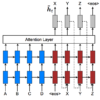The Keras deep learning library provides an implementation of the Long Short-Term Memory, or LSTM, recurrent neural network. As part of this implementation, the Keras API provides access to both return sequences and return state. The use and difference between these data can be confusing when designing sophisticated recurrent neural network models, such as the […]










